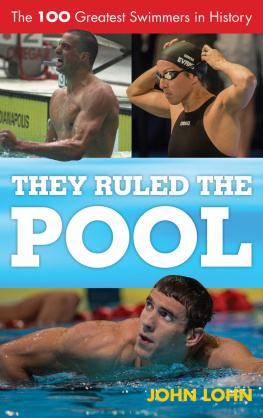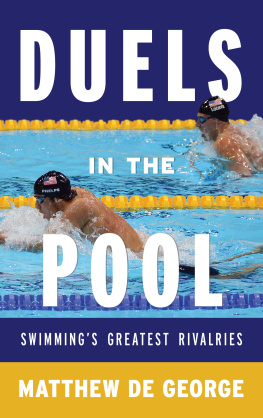Scarecrow Swimming Series
Series Editor: John Lohn
The Scarecrow Swimming Series looks at competitive swimming from a number of perspectives, providing readers with the historical context of the events, athletes, and developments that have shaped the sport.
They Ruled the Pool: The 100 Greatest Swimmers in History , by John Lohn, 2013.
They Ruled the Pool
The 100 Greatest Swimmers in History
John Lohn
Scarecrow Swimming Series

THE SCARECROW PRESS, INC.
Lanham Toronto Plymouth, UK
2013
Published by Scarecrow Press, Inc.
A wholly owned subsidiary of The Rowman & Littlefield Publishing Group, Inc.
4501 Forbes Boulevard, Suite 200, Lanham, Maryland 20706
www.rowman.com
10 Thornbury Road, Plymouth PL6 7PP, United Kingdom
Copyright 2013 by Scarecrow Press, Inc.
All rights reserved. No part of this book may be reproduced in any form or by any electronic or mechanical means, including information storage and retrieval systems, without written permission from the publisher, except by a reviewer who may quote passages in a review.
British Library Cataloguing in Publication Information Available
Library of Congress Cataloging-in-Publication Data
Lohn, John, 1976
They ruled the pool : the 100 greatest swimmers in history / John Lohn.
pages cm (Scarecrow swimming series)
Includes bibliographical references and index.
ISBN 978-0-8108-8746-6 (cloth : alk. paper) ISBN 978-0-8108-8747-3 (ebook)
1. SwimmersUnited StatesBiography. I. Title.
GV837.9.L64 2013
797.2'1092dc23 2012048706
 The paper used in this publication meets the minimum requirements of American National Standard for Information SciencesPermanence of Paper for Printed Library Materials, ANSI/NISO Z39.48-1992. Printed in the United States of America.
The paper used in this publication meets the minimum requirements of American National Standard for Information SciencesPermanence of Paper for Printed Library Materials, ANSI/NISO Z39.48-1992. Printed in the United States of America.
Contents
Acknowledgments
This book is dedicated to my family, whose support through the years has provided strength and made this endeavor possible. To my wife, Dana: You have been a constant source of encouragement since the day we met, and every day were together is a blessing. Our twin daughters, Taylor and Tiernan, light up the world with their smiles and have added so much joy to my life. To my parents: Not a day goes by when your guidance through the years goes unnoticed or unappreciated. Finally, a sincere thank-you goes to Peter Bick, a friend I met through the swimming world and a talented photographer, who generously contributed the images contained in this book.
Introduction
The Purpose
Put a bunch of fans in a room, and it is inevitable that an argument will break outsooner rather than laterover who was the best in a particular sport. Baseball debates will include Babe Ruth and Willie Mays. Football battles will feature Jim Brown and Joe Montana. Basketball arguments will pit Wilt Chamberlain against Michael Jordan. And those are just the well-known names.
A profile of swimming does not rival that of the aforementioned sports. However, that does not mean there is no room for healthy debate between fans. Like any sport, there are enough knowledgeable fans willing to look across the sports landscapeboth present and pastand determine a pecking order for the athletes who have made the pool their athletic milieu.
So goes the purpose of this book. They Ruled the Pool seemed like an appropriate title for an endeavor that aims to rank the top-100 swimmers in history. Selecting the title, though, was the easiest part of the process. The difficult task was comparing and ranking hundreds of athletes across various eras, events, and countries. It required the dissection of accomplishments and record performances, discussions with those who possess expertise in the sport, and a good deal of revision.
This book was the end result, and while it does not represent an undisputed ranking of the top-100 swimmers the world has seen, the list was thoroughly compiled and reflects what has been achieved in more than 100 years of competitive action. And, if nothing else, this book can serve as a launching point for one of those debates that might not be settled but that is part of the fabric of sports.
The Process
So what was the process for selecting the 100 greatest swimmers in history? It was based on a considerable amount of research and relied on numerous conversationspast and presentwith those who regularly cover the sport, as well as coaches who have a feel for the history of swimming.
The first step of the process was to create a pool (pardon the pun) of swimmers from which to choose. By analyzing accomplishments at the international level, I identified approximately 200 individuals as candidates for inclusion. From that point forward, I whittled the list down.
The first athletes selected were those with the greatest individual Olympic success, a group including the likes of Michael Phelps, Mark Spitz, Dawn Fraser, and Krisztina Egerszegi. While Phelps and Spitz delivered the finest Olympic performances in history during their respective eras, Fraser and Egerszegi were the first two swimmers to win an Olympic title in the same event at three consecutive Olympiads.
I continued to select athletes based on several factors, from Olympic medals to world-record performances to medals won at the World Championships. In some cases, where athletes competed in the same era, I assessed head-to-head competition. Versatility, too, played a role, with swimmers covering a variety of strokes receiving additional consideration.
Ultimately, I pared the list down to the 100 names included in the book, but a final step was required. They needed to be ranked from 1 to 100. Accomplishing this task required a repeat of the initial processweighing Olympic performances, world records, and World Championship results. However, in this ranking stage, I placed a greater emphasis on comparing athletes from similar eras. Once that order was established, I completed a cross-era analysis.
There will be disagreements on the final order, which is a normal reaction when it comes to a book of this nature. What cannot be argued is the exhaustive nature of the selection process, a multipart ordeal that measured a number of factors.
The Top Two... Then?
If there was one aspect of this project that qualified as easy, it was the identification of the individuals for the number 1 and number 2 positions on the list. As difficult as it was to determine who was slotted 13th and who was slotted 14th, figuring out the top of the chart took little effort. Michael Phelps and Mark Spitz were slam-dunk choices.
Its fitting, really, for Phelps and Spitz to headline the top-100 list, for as long as the sport is analyzed on a historical basis, the two American men will be linked. It was Spitz who set the standard for excellence in swimming, destroying the record books in the late 1960s and early 1970s and punctuating his career with the greatest Olympic performance of all time.
At the 1972 Olympics in Munich, Spitz was perfect. He entered seven events and won them all. In itself, that accomplishment was staggering. Spitz, though, took on legendary status when each of his victoriesfour individual and three relaywas delivered in world-record time. Spitz became an instant icon, and his greatness went unmatched for more than three decades.
Then Phelps came along.
As the teenager from Baltimore set more and more world records and excelled across numerous disciplines, the inevitable comparisons surfaced. Was Phelps the second coming of Spitz? Ultimately, the answer was nohe was more. However, it was a process for Phelps to surpass a man who was once deemed untouchable.













 The paper used in this publication meets the minimum requirements of American National Standard for Information SciencesPermanence of Paper for Printed Library Materials, ANSI/NISO Z39.48-1992. Printed in the United States of America.
The paper used in this publication meets the minimum requirements of American National Standard for Information SciencesPermanence of Paper for Printed Library Materials, ANSI/NISO Z39.48-1992. Printed in the United States of America.